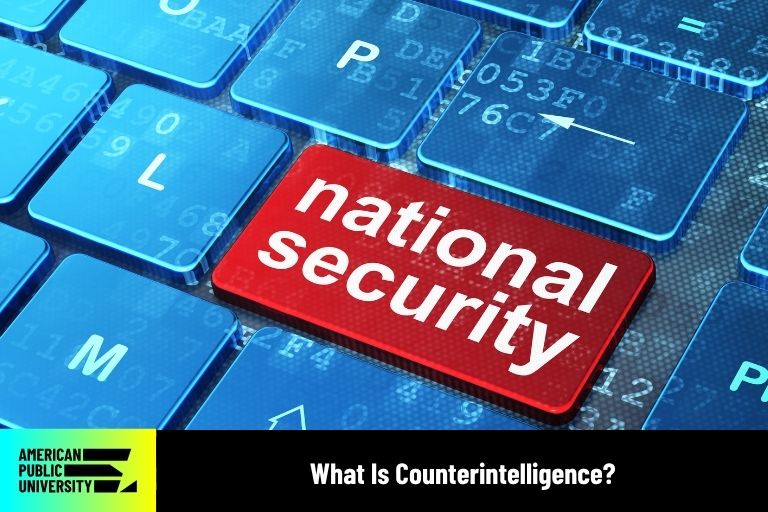07/29/2025

Exploring Counterintelligence’s Role in National Security
If you're interested in national security, international affairs, or intelligence work, counterintelligence is a field worth exploring. It plays a significant role in defending sensitive information and protecting institutions from foreign intelligence threats. But what is counterintelligence, exactly?
In academic settings, students studying counterintelligence examine how to detect and prevent espionage, sabotage, and subversion—activities that can pose risks to government agencies, private organizations, and infrastructure systems. Coursework in this area may cover intelligence operations, threat assessment, and cybersecurity, offering a foundation in both theoretical frameworks and applied practices.
If you're pursuing a degree in criminal justice, intelligence studies, or homeland security, counterintelligence may complement your interests in security-focused careers.
How Counterintelligence Supports the Intelligence Community
Students studying the intelligence community often encounter counterintelligence within broader national defense strategies. Federal agencies use trained personnel to identify and respond to internal and external threats that could compromise secure operations.
Through coursework or simulations, students can examine how intelligence organizations coordinate efforts to protect data, personnel, and infrastructure. This area of study emphasizes the development of systems intended to help reduce exposure to security threats.
Why Counterintelligence Matters for National Security
National security involves more than military defense—it also includes the protection of infrastructure, communication systems, and classified materials. Students focused on security or intelligence degrees may study how counterintelligence contributes to safeguarding these assets.
Academic programs may address topics such as defense strategy, operational risk, and how agencies identify foreign intelligence services that target sensitive information. These lessons are intended to provide students with insights into how protective measures are developed and evaluated.
Counterintelligence and Foreign Intelligence Threats
Foreign intelligence services seek sensitive information to advance their nation’s political, economic, or military objectives. These actors may target government agencies, defense contractors, or technology companies.
If you're studying counterintelligence, you'll likely examine how these services operate, what assets they pursue, and how they exploit vulnerabilities. Students may learn about cyber tactics, human intelligence, and surveillance strategies used to collect data unlawfully. Gaining an understanding of these tactics may help students identify potential risks and evaluate protective strategies.
Studying Economic Espionage in Counterintelligence Programs
Economic espionage is a key topic in many counterintelligence courses. It involves efforts by foreign entities to acquire trade secrets, research, or proprietary data without authorization.
Academic study in this area often includes case-based analysis of real-world incidents and strategies used by organizations to protect intellectual property. This knowledge is particularly relevant to those interested in fields like cybersecurity, business intelligence, or public policy.
Types of Counterintelligence Activities Covered in Academic Programs
Counterintelligence is a set of activities designed to detect, deter, and neutralize threats. These activities are often broken down into categories that students encounter during academic study.
Examples include:
- Threat analysis and risk assessment: Learning how to evaluate vulnerability and predict hostile behavior.
- Personnel security: Understanding how agencies vet employees and monitor insider threats.
- Deception and counter-deception: Examining how agencies use controlled information to mislead foreign intelligence services.
- Cyber defense: Understanding how digital systems are monitored and protected.
Students may also consider legal and ethical implications, which are central to public service and law enforcement contexts.
Counterintelligence and the Challenge of Insider Threats
Insider threats involve individuals with authorized access who may misuse information. This topic is emphasized in academic programs related to intelligence, military security, or federal investigations.
Some programs may cover how organizations use behavioral indicators, vetting procedures, and investigative techniques to identify these risks. Understanding insider threats is considered a critical component of counterintelligence education.
Cyber Threats in Modern Counterintelligence
As digital technology evolves, more intelligence-related activities occur online. Many academic programs now include coursework in cybersecurity and digital risk management.
Some academic programs may introduce cyber tactics including phishing and malware as part of broader coursework, along with the role of counterintelligence in identifying and mitigating these threats. This area of study is particularly relevant for those interested in the intersection of technology and national security.
The Role of Intelligence Analysis in Counterintelligence
If you're drawn to data analysis and critical thinking, you may be interested in the analytical side of counterintelligence. Intelligence analysis involves reviewing patterns, monitoring communication channels, and interpreting complex data to assess threats.
Students enrolled in certain intelligence-related courses might be introduced to how analysis drives resource allocation, supports operations, and shapes national counterintelligence strategies. Understanding these concepts may offer useful insights for students exploring roles in national security or intelligence-related sectors.
Using Risk Assessment in Counterintelligence
In most counterintelligence-focused programs, students are introduced to risk assessments as a core part of defense planning. This process involves identifying what assets are most valuable, how they might be targeted, and what countermeasures are most effective.
Through simulations or case-based learning, students may practice building their own risk frameworks, valuable preparation for working in government agencies, private security firms, or policy organizations.
Collaborative Strategies in Counterintelligence Operations
Counterintelligence requires coordination between agencies and information-sharing across national and international boundaries
Students may study how agencies collaborate on threat mitigation and how partnerships with the private sector contribute to identifying risks such as economic espionage or foreign interference.
Simulations That Reinforce Counterintelligence Training
Some programs offer hands-on training modules or simulations to reinforce counterintelligence concepts. This training may include role-playing scenarios, behavioral observation techniques, or mock briefings that simulate real-world conditions.
Such activities aim to help students apply concepts in realistic contexts and gain experience with tools used in counterintelligence work.
Potential Career Paths in Counterintelligence
For students pursuing studies in intelligence, cybersecurity, or national security, counterintelligence represents a specialized field of academic focus. As global threats evolve, organizations continue to require professionals who can evaluate security risks and apply protective strategies.
Graduates from related fields may pursue opportunities in areas such as federal agencies, military branches, or private firms, counterintelligence provides a framework for understanding how intelligence work supports larger defense objectives.
Learn more about potential career opportunities in counterintelligence by exploring "What Can You Do With a Counterintelligence Degree?".
Disclaimer: Employment outcomes depend on various factors including individual qualifications and job market conditions.

